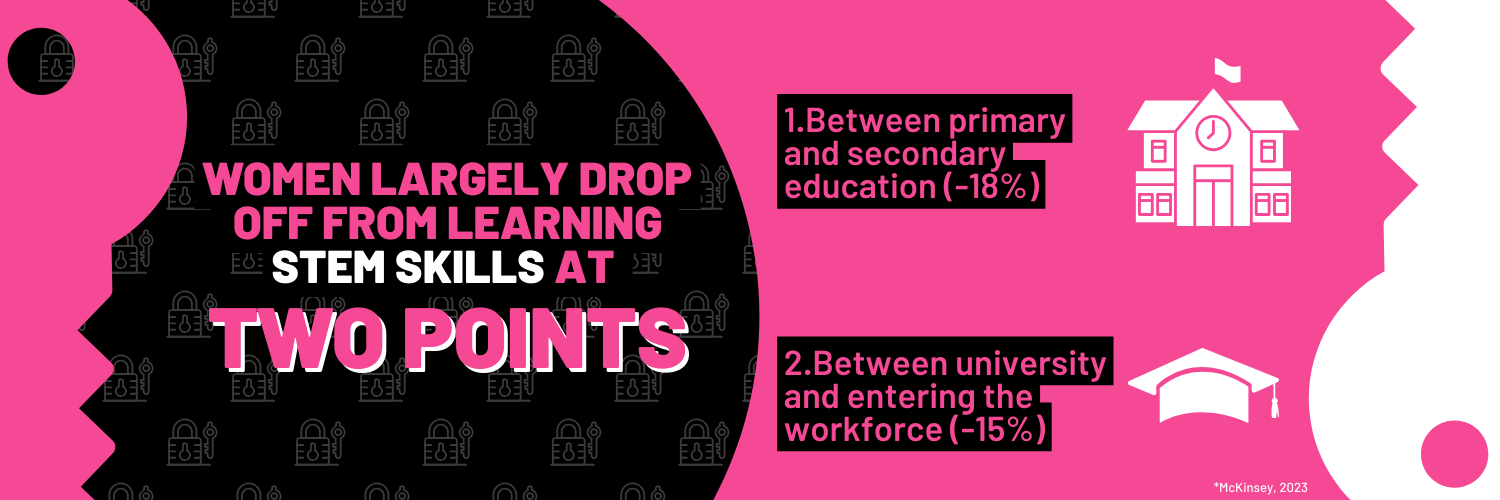Women Are the Key to Solving the Global Tech Skills Shortage, Here’s Why
By Paris Fawcett

Amidst one of the fiercest talent shortages the UK has faced, the search for tech hires has become business-critical. Over the past year, an overwhelming 95% of all tech employers have faced trouble when hiring for roles, forcing companies into a relentless competition to find staff from a limited talent pool. Yet, the effects of this talent scarcity extend far beyond job vacancies; affecting profit, productivity and performance.
It’s well understood that gender disparity is particularly evident in the tech sector, where women only take up 26% of the workforce despite constituting half of the labour market. And with McKinsey projecting that if Europe doubled the presence of women in the tech workforce, it would close the talent gap and fuel a GDP growth of €260 billion to €600 billion, it’s clear that employing more women is an economic necessity. In solving hiring challenges, the often overlooked female talent pool emerges as the answer.
Understanding the global talent shortage
In a recent study conducted by the British Chambers of Commerce of over 5,600 firms, it was found that 82% of all businesses had faced recruitment difficulties. Alex Veitch (Director of Policy and Public Affairs) commented: “Today’s findings reveal that British businesses are facing the highest level of recruitment difficulties on record… Instead of seeing any easing of our extremely tight labour market, this issue only continues to head in the wrong direction.”
This situation is not only confined to the UK but stretches internationally. Insights from the U.S. Census and Bureau of Labor Statistics underline that, despite population and labour force growth, the work force actually shrunk in the pivotal age groups of 16-24 (the historical entry-level talent pool), and 45-54 (the historical leadership talent pool).
Likewise, in their report of the European labour market, The Financial Times reported: “Within the EU, only 68 per cent of women aged between 20 and 64 are in work – 10 percentage points less than the proportion for men, according to OECD data. The UK figures are similar.”

How it started: global pipeline problems
So, how did we get here? To begin, the digital economy’s rapid rise has created an unprecedented demand for tech roles that is disproportionate to the body of graduates qualified to do them. The World Economic Forum recently listed ‘technological literacy’ is 2023’s third fastest-rising skill that is sought after by employers. Corresponding with this finding, Adzuna, the job search engine, reported the highest number of tech vacancies in 10 years in early 2022, with the majority being senior rather than junior roles.
Despite this rise in vacancies, the gender digital skills gap is also becoming more pronounced. Compared to their male counterparts, there is a significant drop off in women pursuing STEM at two points: during the transition to university (a drop of 18%) and during the transition from then to the workplace (a further drop of 15%). Currently, women make up 22% of the European tech workforce. This is set to decline to 21% by 2027. Relying on the educational system is not an option; hiring organisations must explore alternative routes to feed their pipeline of early careers talent and do more to support their female staff to enter mid-level and senior roles.
How it’s going: women as the key to the global tech skills shortage
In the face of the aforementioned challenges, UK Tech draws attention to the need for comprehensive support for women in the workplace:
“In addition to the lack of training for those in the workforce, there is a significant amount of talent across the UK from underrepresented communities that remains untapped and often ignored. It is our collective responsibility as an industry to engage people who struggle to access work or face numerous barriers during application and ensure equal opportunity to access the required skills for a job in tech.”
In August, Code First Girls released our Graduate Outcomes report which shared that 95% of our CFGdegree candidates did not come from a Computer Science background, and 59% didn’t study a STEM degree either. This demonstrates that women, later in life, are choosing to transition into the technology industry, despite not having the traditional educational training. Non-stem graduates, career-switchers and tech returners are pockets of women in which tech employers can unlock potential.
A brighter future: strategies to solve your skills gap
If you are not already, how can you be a part of driving change in tech through creating more diverse tech workforces? There are numerous things you can do (explore research and insights for more!), below are some key starting points across attraction, retention and progression.
Attraction
- Dismantle the rigid criteria that hinders non-STEM candidates from accessing entry-level roles and instead focus on education, mentoring and coaching women as they enter the tech workforce.
- Ensure that your job advert highlights the benefits that women want such as flexible working, fair remuneration, reproductive health care policies and clear career progression.
- Audit hiring systems for bias – remove gender-specific wording on job ads, experiment with blind hiring etc.
Retention
- Focus on supporting the women in your organisation by championing diversity and inclusion practises within the workplace. Instilling a zero-tolerance stance against discrimination will foster an environment where women feel valued.
- Conduct regular listening activities where staff are able to give feedback and implement staff satisfaction as one of your company’s KPIs.
- Support a healthy work-life balance by enacting digital wellness practices and taking an individualised approach to ensuring your employees are receiving the support that they need in the workplace.
Progression
- 54% of women in tech roles leave due to a lack of clear advancement opportunities. Cultivating an environment of growth, where women feel empowered to upskill and develop will not only encourage retention but boost the richness of skills within your senior management team.
- Invest in reskilling programmes for non-IT professionals in your organisation. Almost three in five IT managers in the US started out in non-IT roles and your existing workforce holds untapped potential to meet tech demands.
- Ensure that you have a robust mentoring programme in place so that employees have a figure to support and help drive their progression.
If you would like an extended guide on how to attract, retain and progress the women in your workforce, take a look at our D&I toolkit for tech employers here.
The Verdict
As businesses grapple with today’s hiring challenges, the solution emerges not through questioning the scarcity, but through active transformation. Women hold the power to solve the tech talent crisis, but only if organisations are prepared to address the barriers they face in the workforce, and provide an environment that champions accessibility, inclusivity and lifelong learning.

